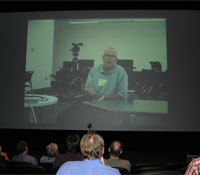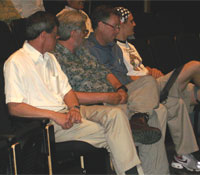Independent Film Director Teams with Calit2 on ?CineGrid? Coast-to-Coast Screening of New High-Definition Movie over OptIPuter Backplane
By Stephanie Sides
|
San Diego, CA, June 23, 2006 -- Many technology developers are convinced that the movie distribution and viewing experience of the future is going to be very different from today’s model. Digital technology, they say, will enable higher-resolution imagery and better sound, using more secure and efficient distribution. In fact, an important step toward this model was demonstrated last week at Calit2.
CineGrid™, a Calit2 initiative directed by Laurin Herr of Pacific Interface (see his lecture at www.calit2.net/newsroom/article.php?id=831 ), is applying dedicated optical networks to support distributed production, editing, and dissemination of digital cinema. The emerging telepresence collaboratory between the J. Craig Venter Institute (JCVI) in Rockville, MD, and Calit2@UCSD (www.calit2.net/newsroom/print_page.php?id=766) supporting a new marine microbial metagenomics project, called CAMERA, offered a novel testbed to experiment with an all-digital infrastructure in this context.
A partnership between Calit2 director Larry Smarr, genome pioneer Craig Venter, independent movie director John Carter, and their respective technical staffs achieved a successful test of real-time streaming of a just-released high-definition movie over a transcontinental gigabit Ethernet optical network. This team included industrial partners QVidium Technologies, Inc., which provided the compression/decompression equipment and attendant technical expertise, and Carter’s production company Capital City Entertainment. Calit2 also used products and services from Sony, CENIC, and the National LambdaRail/CAVEWave.
The movie was played from a high-definition Sony JH-1 HDCAM videotape player at JCVI in Rockville, MD, and fed into QVidium’s high-definition-video-over-IP gateway (using QVidium's advanced video transport technologies) at a resolution of 1920x1080 pixels. Then it was sent out over a dedicated optical link to Calit2 in San Diego where it was presented in the same resolution via a Sony SRX-110 projector on the theater’s Stewart 32’x19’ screen to the Calit2 technical team. The transmission used MPEG2 compression on both ends, and the images stayed digital end to end without conversion to/from analog. The transmission was based on two core technologies – forward error correction and synchronization – to achieve jitter-free reception.
|
||||
Said Smarr, “We’re applying technology we developed in the OptIPuter project (www.optiputer.net) to support research and development in a new domain: movie distribution and viewing. Our CineGrid project is testing exactly these kinds of capabilities to figure out what works and what doesn’t quite work in the system. Then we iterate from there until we get it right. We’re delighted John wanted to work with us on this.”
The movie in question, “Fatwa,” released to movie theaters and on DVD just the day before this event, is a timely and provocative (unrated) political thriller about the current state of terrorism in the world.
The movie, which premiered at the Atlanta Film Festival a few days before, was produced, from concept to final version, over a one-year period with a budget of $750,000. The shooting itself took just 20 days. The CineGrid test featured network-enabled audio/video discussions between the director at JVCI and the Calit2 audience before and after the showing.
Said Carter, “Craig Venter introduced me to Larry Smarr. I was given a tour of the Calit2 facility at UCSD and instantly wanted to take advantage of their capabilities. Usually academic institutions are not as open to working as quickly as a project like this demands. Taking a large amount of information, such as a full-length dramatic motion picture, moving it from one coast to another with virtually no delay, and projecting it with the quality of audio and video we achieved is the realization of a dream our industry has had for a long time. Larry and his team made it look easy, even though I know it wasn’t. The technical success of this screening clearly opens some doors to do more.”
The results of this pioneering test did reveal room for technical improvement. As the next step in this collaboration, Carter agreed to provide Calit2 with a digital copy of his master so that the audience could compare the viewer experience over the network vs. viewing locally.
“The demo was a remarkable achievement involving extensions of the network, lots of complexities, and a tight timeframe,” said Paul Hearty, director of the Rogers Communication Centre at Ryerson University. “Let me commend the team at Calit2 and the Venter Institute for this success. And it certainly validated our decision at Ryerson and Rogers to partner with OptIPuter and CineGrid.”
About Calit2
The California Institute for Telecommunications and Information Technology, a partnership between UC San Diego and UC Irvine, houses more than 1,000 researchers organized around more than 50 projects on the future of telecommunications and information technology and how these technologies will transform a range of applications important to the economy and citizens' quality of life. www.calit2.net
About the J. Craig Venter Institute
J. Craig Venter Institute is a not-for-profit research institute dedicated to the advancement of the science of genomics; understanding of its implications for society; and communication of those results to the scientific community, the public, and policymakers. Founded by J. Craig Venter, Ph.D., Venter Institute is home to approximately 200 staff and scientists with expertise in human and evolutionary biology, genetics, bioinformatics/informatics, information technology, high-throughput DNA sequencing, genomic and environmental policy research, and public education in science and science policy. J. Craig Venter Institute is a 501(c)(3) organization. www.venterinstitute.org
About OptIPuter
The OptIPuter is a five-year, $13.5-million project funded by the National Science Foundation. It will enable scientists who are generating massive amounts of data to interactively visualize, analyze, and correlate their data from multiple storage sites connected via optical networks. The California Institute for Telecommunications and Information Technology, a UCSD/UCI partnership, and the Electronic Visualization Laboratory at the University of Illinois at Chicago (UIC) lead the research team. Academic partners include the San Diego Supercomputer Center, Scripps Institution of Oceanography, and School of Medicine at UCSD, Northwestern University, San Diego State University, University of Southern California/Information Sciences Institute, University of California-Irvine, Texas A&M University, University of Illinois at Urbana-Champaign/National Center for Supercomputing Applications; and, affiliate partners at the U.S. Geological Survey EROS, NASA, University of Michigan, Purdue University, University of Amsterdam and SARA Computing and Network Services in The Netherlands, CANARIE and Communications Research Centre in Canada, the Korea Institute of Science and Technology Information (KISTI) in Korea, and the National Institute of Advanced Industrial Science and Technology (AIST) in Japan; and, industrial partners Big Bangwidth, Calient Networks, Chiaro Networks, Glimmerglass Networks, IBM, Lucent Technologies, Rincon Research Corporation, Sun Microsystems and Telcordia Technologies. www.optiputer.net
About CAMERA
The Community Cyberinfrastructure for Advanced Marine Microbial Ecology Research and Analysis is a high-performance computational collaboratory that supports metagenomics research—analyzing microbial genomic sequence data in the larger context of microbe communities and the environmental metadata associated with the sequence data (e.g., what other species are present, the chemical and physical conditions in which the microbes are sampled, how these communities change over space and time, etc.). CAMERA will grow in value to include new sequences, genes, and gene families, together with their annotations and associated environmental metadata. CAMERA, awarded in early 2006, is a seven-year project with $24.5M in funding from the Gordon and Betty Moore Foundation. camera.calit2.net
About CineGrid
CineGrid is a Calit2 initiative to leverage next generation cyberinfrastructure to connect people around the world experimenting with “extreme” digital media via secure photonic networks. For more information, contact Laurin Herr, President, Pacific Interface, at <laurin@pacific-interface.com >




